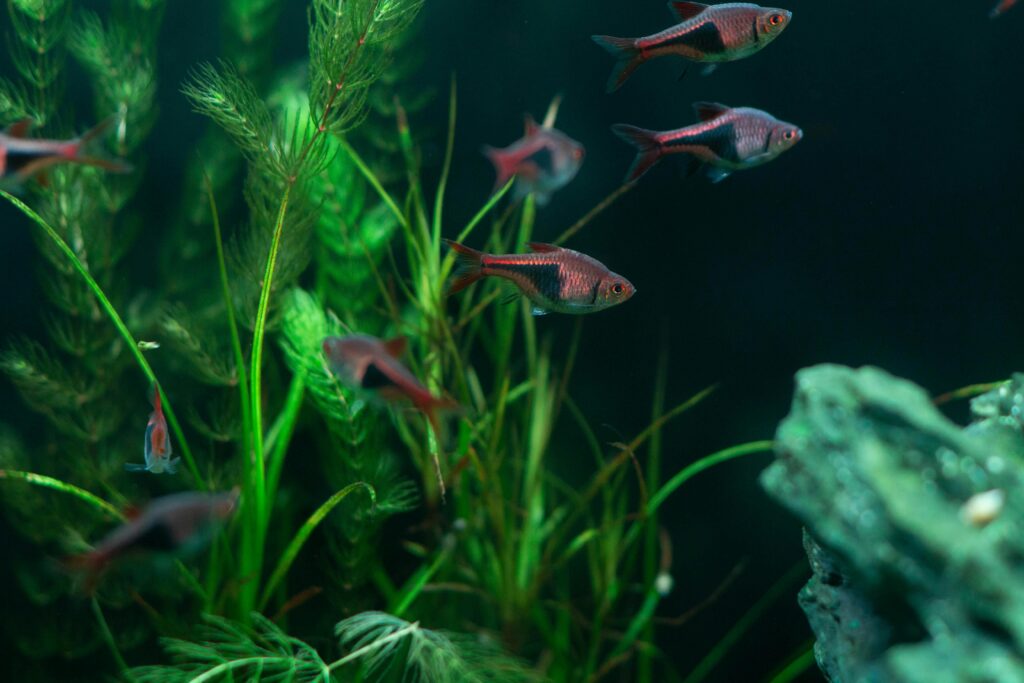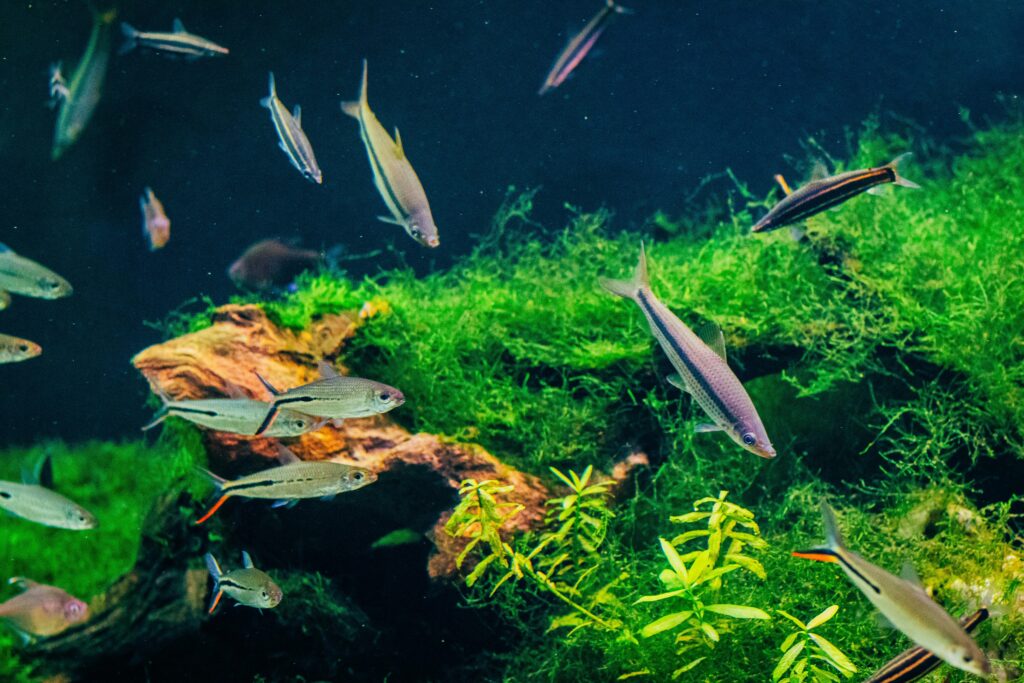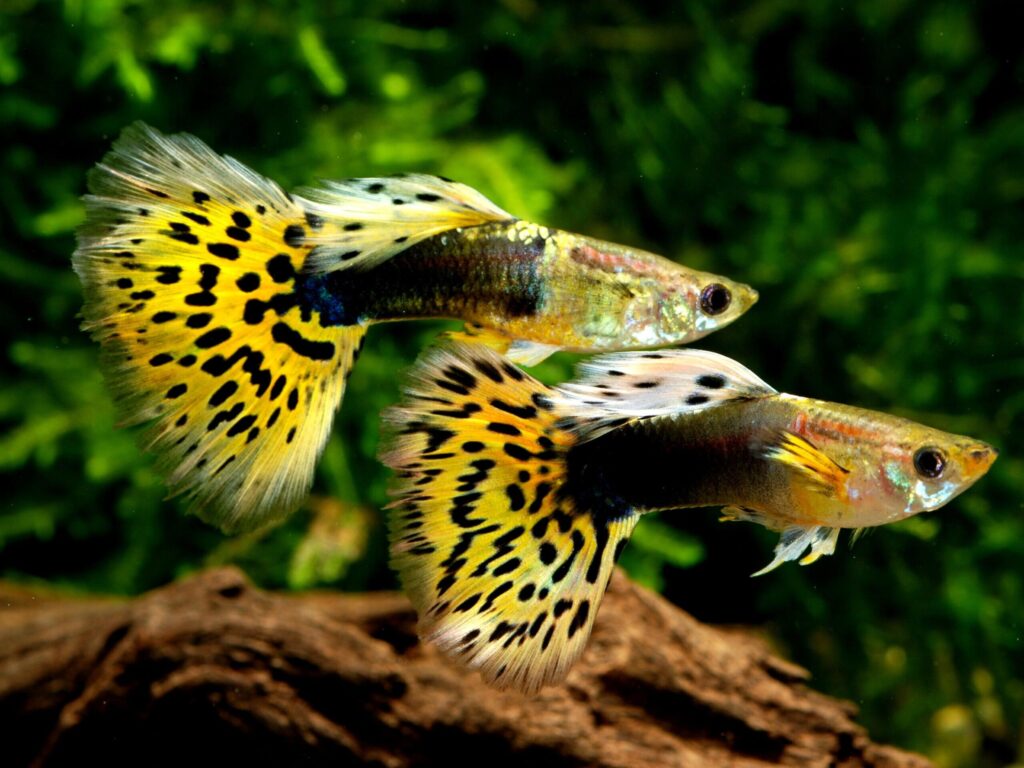Creating a harmonious aquarium filled with peaceful fish is one of the most rewarding challenges for aquarists. While some combinations of fish are tried-and-true successes, others depend on factors like tank size, decorations, and fish personalities. By considering key aspects of fish compatibility, you can build an aquarium where all your fish thrive.

Harlequin Rasbora (Trigonostigma heteromorpha) – A vibrant and peaceful addition to any freshwater community aquarium.
Aquarium Size: Bigger Tanks Mean Happier Fish
The size of your tank is crucial for maintaining peace among your fish. Overcrowding causes stress, leading to aggression and territorial disputes. A good rule of thumb is one inch of adult fish per gallon of water, but territorial fish require more space. Always consider that fish grow and that the actual water capacity of a tank is reduced by gravel, decorations, and equipment.
For example, a 15-gallon aquarium often holds significantly less water than expected. In larger tanks (30 gallons or more), fish can establish territories and coexist more easily. Consider starting with a tank like this one designed for optimal space.
Tank Dimensions: Shape Influences Behavior
Tank dimensions play a critical role in fish behavior. Active swimmers like danios and barbs prefer wide, horizontal tanks that allow them to stretch their fins, while taller, narrow tanks suit slow-moving fish like angelfish, gouramis, or discus. Choosing the right shape reduces stress and makes your fish feel at home.
Looking for a tank with great proportions for your fish? Explore this tank option for active and peaceful species.
Decorations and Plants: Hiding Spots and Territories
Aquarium decorations and plants are essential for creating a peaceful environment. Territorial species like cichlids rely on rocks, caves, and driftwood to establish boundaries. Similarly, schooling fish like tetras and rasboras need tall plants for shelter and security. Rearranging decorations when introducing new fish can prevent established residents from dominating the space.
To create a visually stunning tank with functional decor, try this collection of naturalistic decorations.

A serene group of Red Tail Hemiodus (Hemiodus gracilis) gliding gracefully in a lushly planted aquarium, showcasing their vibrant red tails and sleek, streamlined bodies
Species Compatibility: Know Your Fish’s Origins
Fish from different regions “speak different languages,” meaning their behavior and communication styles may clash. When stocking your aquarium, research your fish species thoroughly. Aim to group fish from the same region, particularly for territorial species like cichlids or certain loaches.
For tools to monitor your aquarium’s health and ensure compatibility, consider this water testing kit.
Fish Behavior and Unexpected Personalities
Fish behavior often varies from one individual to another. While general patterns can guide your choices, unexpected aggression or peace may arise. Always be prepared to adapt by having a quarantine tank ready for incompatible fish.
Maintaining a peaceful tank is easier with the right setup. Start with these essential accessories to ensure harmony in your aquarium.

Additional Tips for Fish Compatibility
- Age and Size Matters: Young fish are more adaptable but may grow into aggressive adults. Likewise, ensure fish are similar in size, as the saying goes: “If a fish fits into another’s mouth, it will end up there.”
- Male-to-Female Ratios: Male fish, particularly cichlids, are often territorial. Keeping more females than males helps diffuse tension.
- Schooling Behavior: Fish like tetras and barbs thrive in groups of six or more. African Rift Lake cichlids, however, do better when slightly crowded to prevent dominance issues.
- Breeding Fish: Fish that breed, especially those practicing parental care, may become highly territorial. A dedicated breeding tank can prevent disruptions to the main aquarium.
Conclusion
Building a peaceful community aquarium requires careful planning, thoughtful fish selection, and the right environment. With a well-chosen tank, appropriate decorations, and compatible species, your fish can live in harmony.
For aquarists looking to enhance their setups, browse these top-rated aquarium products for a thriving aquatic community. Whether you’re starting with a small tank or a large-scale system, the right choices will ensure your fish live stress-free and happy lives.
Related reading
How to Set Up Your Very First Freshwater Aquarium: A Step-by-Step Guide
Discus Demystified: A Practical Guide to Keeping the King of the Aquarium
The Ultimate Guide to Preventing and Treating Aquarium Fish Diseases
